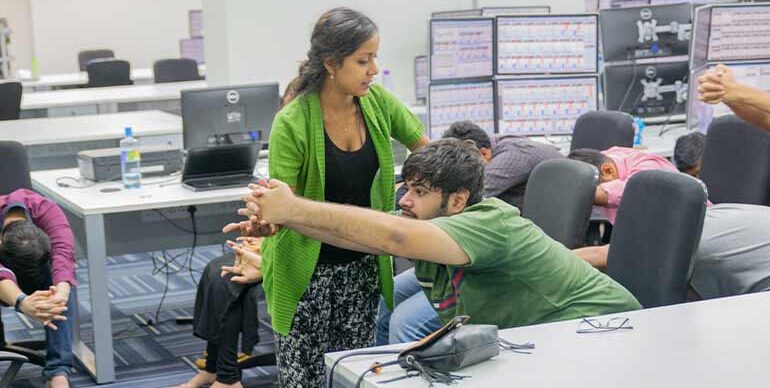
Born to Move
People are meant to move about. We traveled as hunters and gatherers up to 20 miles every day. To survive, we had to migrate. Additionally, we were made to eat food — real, unprocessed stuff. We are built to function well under duress and then procreate. We were made for social interaction and romantic love. And finding happiness and purpose in life is part of our basic wiring and design.
These fundamentals, expressed via the voices of philosophers like Aristotle and Viktor Frankl, poets like Pablo Neruda, and pop singers like Lady Gaga, are at the heart of what humans have been searching for throughout history. More than ever, we are discussing these timeless concerns while frantically trying to identify the solutions.
What is Wellness
At its essence, wellness is about returning to our natural behaviors. But more and more, we are being asked by modern society to perform tasks for which we were not created and built for. We are culturally required to sit even though we are born to move. We are biologically designed to eat wholesome foods, but because of our hectic schedules and hazardous surroundings, we often choose processed foods that give us a quick but fleeting sense of satisfaction. Our society idolizes being busy and being constantly on the go whereas we are programmed to alternate between stress and relaxation.
Although our virtual social networks on social media are constantly growing, many of us still feel alone in a sea of fierce competition. Our society places pressure on us to be available round-the-clock and to meet ever-increasing professional obligations, leaving us with little time for relaxation and renewal. It’s easy to see why so many of us feel exhausted and empty at the end of the day.

Popularity of Workplace Wellness
The popularity and reputation of workplace health programs have been rising in this laboratory of biological-cultural incompatibilities. One may define workplace wellness as any form of concerted attempt to help workers be more human at work, including moving more, eating more naturally, achieving balance, making meaningful connections, and working toward a higher goal. If done correctly, workplace wellness has the power to counteract the negative impacts of the toxic and increasingly demanding environment and culture we now find ourselves in. If not done correctly, workplace wellness might come off as just another top-down compliance initiative that has little to do with actual well-being and more to do with ticking boxes and passing exams!
Implementing Workplace Wellness
Workplace wellness shouldn’t be difficult to implement and contentious, yet it has. In reality, there are a number of incredibly easy and affordable things that any business — and any individual working there — can do to foster a positive work environment that boosts productivity. Every firm currently possesses the tools and capacity needed to create workplace wellness that works. But this is precisely where a wellness company like Wellintra fitness comes in because we have the experience and the knowledge to guide you on the correct workplace wellness initiatives that can bring results.
We can influence employees’ health and happiness and foster an overall culture of well-being at work by implementing promising workplace wellness practices as well as ideas from related disciplines like education, learning and development, organizational development, psychology, and even “design thinking,” which encourages employees to think like a designer to come up with innovative solutions. We can design workplace wellness that functions and assist workers in fulfilling their higher purpose.
Anyone who is responsible for or interested in workplace wellness should contact us by sending us an email. You might be the official wellness liaison, a human resources manager, a safety coordinator, a senior executive looking to promote wellness throughout the entire company.

The Tidal Wave of Health Problems
We are all struggling to live up to our potential due to a tidal wave of obesity, chronic illnesses, high levels of stress etc. The numbers are staggering. The vast biological-cultural mismatches that we have jointly produced in India, and increasingly as a global community, is the main cause of this tidal wave.
In India, there are now twice as many obese and overweight people as there were in 1980. By 2030, nearly half of us will be obese if current trends continue. Nearly one in two Indians suffers from at least one chronic illness. The leading cause of death remains heart disease. More than one in ten Indians, including more than one-third of Indian adults, have type 2 diabetes, according to the Centers for Disease Control and Prevention. By the year 2050, a third of us will have diabetes if we stay on our current course.
The tidal tsunami we’re confronting can be summed up in three terms, says David Katz, head of the Yale Prevention Research Institute: “feet, forks, and fingers.” We must improve our eating habits (forks), get more active (feet), and give up smoking (fingers). The frightening numbers make it painfully clear that we need to make these healthy decisions, but the statistics are silent on how to inspire and empower ourselves to do so.

Educating Employees
Every employee knows what adjustments they should make, with startlingly few exceptions, but extremely few people are able to really implement these changes. We are aware that we must consume more fruits and vegetables, abstain from smoking, increase our physical activity levels, keep our weight in check, get enough rest at night, manage our stress, and make time for our loved ones. However, very few of us are capable of applying this knowledge. This is the “knowing and acting gap,” as I like to call it. This gap not only causes us a great deal of needless misery, but it also costs us many crores of rupees annually.
Examples of the gap between knowledge and action are everywhere. For instance, while every qualified nurse and medical professional is fully aware of the health hazards linked to obesity, some studies have indicated that the obesity incidence among medical professionals is considerably higher than the national average! The yearly tradition of making New Year’s resolutions is another excellent illustration of the knowledge and action gap. Every year, many of us make resolutions to better our health, such as giving up smoking, eating healthier, or joining a gym. Statistical data reveals that a startling 88% of these resolutions fail.
Most of us struggle with how to accomplish something rather than what to do. A growing need for solutions is demonstrated by the growth of books, blogs, YouTube videos and speeches on behavior change and habit building. For instance, many employees frequently inquire, “How can I lose weight?” You can respond, “Well, you need to consume healthier meals and exercise more.” They usually say, “Yeah, yeah — I know that,” as usual. You have to ultimately understand that they aren’t requesting advice. How do I do it? – they are asking.

Effective Workplace Wellness
In order for workplace wellness to be genuinely effective, we must first address the environment and culture, then the individual. For instance, our world has created an environment where sitting is usual and moving is unnatural. Our urban environments are primarily geared toward driving rather than walking. “In today’s technology-driven plasma-screened-in world, it’s easy to forget that we are born movers like other animals but then we’ve manufactured movement right out of our existence.
Workplace wellness enters the scene at this point. Just the concept of workplace wellness requires bravery given that our brains are predisposed to reject change, There is a huge gap between what we know we should do and what we actually do.
Effective workplace wellness initiatives are more important now than ever because most adults spend the bulk of their waking hours at work. A collectively unhealthy lifestyle can be left behind, and a collectively healthy one can be entered, thanks to workplace wellness. That’s a good idea, but how do we carry it out?
Stay tuned to our blog section for more articles on workplace wellness. In the meantime you can send us an inquiry if you are unsure about how and where to start in the world of employee and workplace wellness!
Do not miss a single article!
Submit your email id to get new articles directly into your email inbox!
- Employee Wellness Programs: They Really Work! - October 21, 2022
- Yoga Teacher Training Standards - November 18, 2021
- Why You Will Never Go Hungry Again - October 25, 2021




Add Review